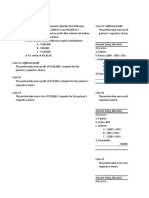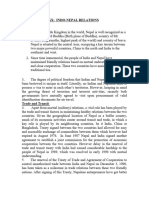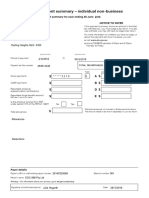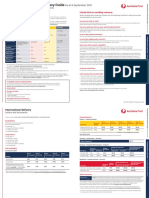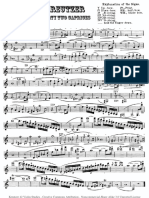India-Cambodia Relations: July 2011
India-Cambodia Relations: July 2011
Uploaded by
Jakhar Vishal SinghCopyright:
Available Formats
India-Cambodia Relations: July 2011
India-Cambodia Relations: July 2011
Uploaded by
Jakhar Vishal SinghOriginal Description:
Original Title
Copyright
Available Formats
Share this document
Did you find this document useful?
Is this content inappropriate?
Copyright:
Available Formats
India-Cambodia Relations: July 2011
India-Cambodia Relations: July 2011
Uploaded by
Jakhar Vishal SinghCopyright:
Available Formats
India-Cambodia Relations Historically, India-Cambodia relations are a product of Hindu and Buddhist religious and cultural influences, emanating
out of India in the 4th 6th century AD, to various parts of South-East Asia. Though Cambodia, like most of its neighbours, is a Buddhist nation, there is a strong influence of Hindu rituals, idolatry and mythology. The pervading influence of Hinduism, Buddhism, and Indian architecture are borne out by the structures at Angkor Wat, Angkor Thom, Bayon, Baphuon and other religious and historical sites in Cambodia. 2. India-Cambodia bilateral relations are warm and cordial. In the 1950s, India was associated with International Control Commission on Indo-China. After the collapse of Khmer Rouge regime, India recognized the Heng Samrin regime and opened its Embassy in Phnom Penh in 1981 when much of the world shunned Cambodia. This factor along with Indias association with the Paris Peace Accords and their finalization in 1991 is fondly remembered by the Cambodian leadership. India also committed military and non-military personnel for the conduct of the UNTAC-sponsored elections in 1993. Furthermore, Government of India responded to an appeal by Cambodian Government to undertake the conservation of the famous Angkor Wat temple during the period 1986 to 1993 at a cost of US$4 million, at a time when peace in the country was yet to be settled. 3. The contemporary times have witnessed expansion of cooperation in diverse fields such as institutional capacity building, human resource development, extension of financial assistance in infrastructure projects, security and defence. On political front, both countries have demonstrated willingness to further enhance bilateral cooperation through exchange of Ministerial visits and through interactions at regional and international forums. From India, prominent high-level visits included Vice President (2001), Prime Minister (2002), External Affairs Minister (2003), Commerce & Industry Minister (2003), Minister of State for External Affairs (2006), Water Resources Minister (2008 & 2010), Panchayati Raj Minister (2009) and President (Sept 2010). Cambodian Dy. PM and Foreign Minister Hor Namhong paid an official visit to India in 2007. Cambodian PM Hun Sen had visited India many times and the last one was in 2007. From Cambodia, other prominent recent visits to India included a multi-party parliamentary delegation (2010), Commerce Minister (2008 and 2011) and Minister of Cults & Religion (2010). 4. Total bilateral trade in the year 2009-10 was US$50.60 million (Indian export of US$45.54 million and import of US$5.05 million). In the year 2010-11 (April to September) it was US$ 31.43 million (Indian export of US$ 28.08 million and import of US$ 3.35 million). Potential exists for enhanced economic engagement between the two countries. To achieve this objective, the First India-Cambodia Trade and Investment Business Forum, Exhibition and Buyer Seller Meet was organized in Phnom Penh on 11-12 November, 2009. A number of trade delegations visited Cambodia during last year to explore business opportunities and held buyers-sellers meets. Bank of India opened its branch in Phnom Penh in May, 2009 and this development is expected to assist in improving bilateral trade and investment ties. 5. Towards capacity building in Cambodia, Government of India has set up in Phnom Penh under IAI Programme Cambodia-India Entrepreneurship Development Centre (CIEDC) in February, 2006 and Cambodia-India Centre for English Language Training (CICELT) in August, 2007. As for Human Resource development, till date, Cambodia has utilized 870 civilian training slots and 96 defence training slots under ITEC. Taking note of increasing demand for civilian training courses, slots for Cambodia under ITEC have been enhanced to 85 from 75 since 2009-2010 and to 90 from 2011-12. Separately, 15 education scholarships have been offered every year, 10 under MGC and 5 under GCSS (enhanced from 2 to 5 w.e.f. 2011-
July 2011
12). An Indian expert in water management was deputed for one year period from June 09 to June 10 under ITEC to assist APSARA Authority at Siem Reap. There have been regular exchanges of cultural troupe performances. Indian TV serials (Zee TV and Star Plus) and Hindi movies (dubbed in Khmer) are quite popular. MoU for setting up of a Chair on Buddhist & Sanskrit Studies at Preah Sihanouk Raja Buddhist University was signed with Cambodian Ministry of Religions & Cults on 5 July, 2010. The Chair had been operational from Oct 2010 to April 2011 and MOU for extension of the Chair for 4 years from 2011 academic session was signed on 4th July, 2011, during visit of Dr. Karan Singh, MP & President of ICCR. During the function, Dr. Karan Singh was conferred the Honorary Degree of Doctor of Letters by the Preah Sihanouk Raja Buddhist University. ICCR-sponsored International Conference on Buddhism Heritage in South East Asia was organized at Phnom Penh on 3-4 December, 2010 with participation of scholars from India, Cambodia, China, Vietnam, Thailand and Indonesia. 6. India has extended bilateral financial assistance to Cambodia through grants and Lines of Credit. Since December, 2003, a team of ASI has been working for restoration of Ta Prohm Temple in Siem Reap with funds provided under ITEC programme. Several projects under Indias Lines of Credit in the areas of electric transmission lines (US$30 million), irrigation (US$30 million) and installation of water pumps (US$5.2 million) are under implementation. During 2002, India gifted medicines and 10,000 tonnes of rice. India gifted 26,000 jars of indelible ink to Cambodia for the general elections in July, 2003. India made a bilateral contribution of US$1 million for the Khmer Rouge Tribunal, the first country to pledge a cash contribution to Cambodias national share of the court of the Tribunal. Proposals for setting up Centre of Excellence in IT and installation of hand-pumps in rural Cambodia under grants-inaid are under process. India is providing financial assistance of approx. US$ 1.7 million for setting up of the Asian Traditional Textiles Museum at Siem Reap under Mekong Ganga Cooperation initiative, for which construction has started in July 10. 7. In the last few years, there has been a steady enhancement of defence cooperation between the two countries. Exchange of visits of defence officials, goodwill visits by Indian Naval Ships (most recently on 12-16 July 2011, Indian Naval Ship INS AIRAVAT visited Sihanoukville Port of Cambodia), supply of medical equipment & other stores and imparting of training courses to RCAF personnel in demining & peace keeping operations, are some of the activities undertaken by the two countries. On security front, India-Cambodia have signed an Agreement on Combating International Terrorism, Organized Crimes and Illicit Drug Trafficking in December, 2005. 8. India and Cambodia cooperate in a number of multilateral and regional foras. Cambodia has been a strong proponent of enhanced interaction between India and the ASEAN. In the context of our Look East policy and the ASEAN, Cambodia is an important interlocutor and a good partner. Currently, Cambodia is the country coordinator for India in the ASEAN. 9. There are about 1500 Indian nationals working in various fields in Cambodia. Most of them are based in the capital city, Phnom Penh. The Indians in Cambodia have formed an association called Indian Association Cambodia. Phnom Penh has a street named after Pt. Jawaharlal Nehru. A bust of Mahatma Gandhi, gifted by India, has been installed at a prominent location in Phnom Penh. ***
July 2011
You might also like
- State of GeorgiaDocument2 pagesState of GeorgiatravisdemitriusNo ratings yet
- Division of Profits and Losses Case #1: Sufficient Profit: Partnership OperationsDocument7 pagesDivision of Profits and Losses Case #1: Sufficient Profit: Partnership OperationsJuliana Cheng100% (3)
- Thesis - Report Final Shahzaib PDFDocument56 pagesThesis - Report Final Shahzaib PDFHamza Tariq75% (4)
- 1 Cambodia November 2017Document6 pages1 Cambodia November 2017Aditya GuptaNo ratings yet
- LaosDocument4 pagesLaosJakhar Vishal SinghNo ratings yet
- Japan ProjectDocument8 pagesJapan Projectistiyak aliNo ratings yet
- High Commission of India Dhaka India-Bangladesh RelationsDocument3 pagesHigh Commission of India Dhaka India-Bangladesh Relationsamoda19906186No ratings yet
- India - Nepal RelationDocument3 pagesIndia - Nepal RelationReckon IndepthNo ratings yet
- India Nepal RelationsDocument4 pagesIndia Nepal RelationsDharmender Singh NarwariyaNo ratings yet
- Israel Final 21Document5 pagesIsrael Final 21Manish MeenaNo ratings yet
- Palestine December 2014 EngDocument3 pagesPalestine December 2014 EngAnaghaNo ratings yet
- Korean Embassy Meets Young Leaders BINUSDocument26 pagesKorean Embassy Meets Young Leaders BINUSAPRILYN EnriqueNo ratings yet
- India-Australia Bilateral Relations: Recent Political InteractionDocument7 pagesIndia-Australia Bilateral Relations: Recent Political InteractionBHAVESH KHOMNENo ratings yet
- Bilateral Relations Between Indonesia and TurkeyDocument6 pagesBilateral Relations Between Indonesia and TurkeyAdil SaadilahNo ratings yet
- Australia January 2012Document5 pagesAustralia January 2012Suraj GaneshNo ratings yet
- India-Nepal Relations A. Overview: UnclassifiedDocument6 pagesIndia-Nepal Relations A. Overview: UnclassifiedSafikul IslamNo ratings yet
- India-Nepal Bilateral RelationsDocument6 pagesIndia-Nepal Bilateral RelationsBad CitizenNo ratings yet
- India-Bhutan 23 March 2023 1Document4 pagesIndia-Bhutan 23 March 2023 1ArchaNo ratings yet
- Srilanka Relation Wid IndiaDocument17 pagesSrilanka Relation Wid IndiabhoopendratNo ratings yet
- SrilankaDocument2 pagesSrilankaSrinivasulu PeramNo ratings yet
- India SriLankaRelationsDocument6 pagesIndia SriLankaRelationsJohn CarpenterNo ratings yet
- India-Israel Relations Political RelationsDocument4 pagesIndia-Israel Relations Political RelationsAlex HalesNo ratings yet
- Sreeja Banerjee 1 20200919033330Document20 pagesSreeja Banerjee 1 20200919033330sreeja.banerjee.097No ratings yet
- Vietnam 13 01 2016Document5 pagesVietnam 13 01 2016SanjayMeenaNo ratings yet
- Safari - 18-Sep-2018 at 1:28 AMDocument1 pageSafari - 18-Sep-2018 at 1:28 AMpranayNo ratings yet
- 14 Japan Nov 2017Document5 pages14 Japan Nov 2017Suchitra SharmaNo ratings yet
- BeninDocument5 pagesBeninChirayu ThakkarNo ratings yet
- JapanDocument3 pagesJapanBrij Raj SahaniNo ratings yet
- Changing Dimensions of Business in IndiaDocument136 pagesChanging Dimensions of Business in Indiarajat_singla100% (1)
- Bilateral Brief India-Japan December 2018Document7 pagesBilateral Brief India-Japan December 2018NipunGuptaNo ratings yet
- Indo Nepal 2Document3 pagesIndo Nepal 2Dipak KaushikNo ratings yet
- India and Singapore Trade RalationDocument13 pagesIndia and Singapore Trade RalationManish DhuriaNo ratings yet
- India-Bangladesh Bilateral Brief Dec 2018Document8 pagesIndia-Bangladesh Bilateral Brief Dec 2018mahima aroraNo ratings yet
- India - Bhutan RelationsDocument4 pagesIndia - Bhutan RelationsLakshya ChoudharyNo ratings yet
- For The Degree ofDocument19 pagesFor The Degree ofAisha sharmaNo ratings yet
- Somalia January 2012Document4 pagesSomalia January 2012Ibrahim Abdi Geele100% (1)
- India-UK Relations Political Relations India and UK Are Bound by Strong Ties of History and Culture. India's MultiDocument4 pagesIndia-UK Relations Political Relations India and UK Are Bound by Strong Ties of History and Culture. India's MultiMehar ChandNo ratings yet
- Brief_on_India_Bhutan_Relations_March_2024Document4 pagesBrief_on_India_Bhutan_Relations_March_2024ishujaglan03No ratings yet
- India-Brazil Relations: TH THDocument4 pagesIndia-Brazil Relations: TH THShehriyab AliNo ratings yet
- JapanDocument3 pagesJapanambikaiNo ratings yet
- India Indonesia PolSciDocument12 pagesIndia Indonesia PolSciRONSHA ROYS ANNANo ratings yet
- India Thailand 2022Document8 pagesIndia Thailand 2022rohityadavengNo ratings yet
- Situational Analysis of Belt and Road Initiative in Nepal 3wjd4lqufyDocument5 pagesSituational Analysis of Belt and Road Initiative in Nepal 3wjd4lqufyAyesha AkterNo ratings yet
- India Japan RelationsDocument2 pagesIndia Japan Relationssudhasingh162900No ratings yet
- Joint Statement Comprehensive Strategic PartnershipDocument8 pagesJoint Statement Comprehensive Strategic PartnershipSonia SefarezieNo ratings yet
- Algeria January 2012Document3 pagesAlgeria January 2012Jitendra RaghuwanshiNo ratings yet
- Indai Kuwait RelationsDocument4 pagesIndai Kuwait RelationsqayyumNo ratings yet
- SrilankaBrief_August2015Document6 pagesSrilankaBrief_August2015dhritikarmokar18No ratings yet
- Remarks by Shri Sanjay Singh, Secretary (East) To Media On PM's Visit To Phnom Penh, CambodiaDocument4 pagesRemarks by Shri Sanjay Singh, Secretary (East) To Media On PM's Visit To Phnom Penh, CambodiaDrAayam GuptaNo ratings yet
- India - Bhutan RelationsDocument19 pagesIndia - Bhutan RelationsAbhishekNo ratings yet
- Unit 4Document7 pagesUnit 4ASHNo ratings yet
- Current-Affairs 2013 Complete Guide - OptDocument167 pagesCurrent-Affairs 2013 Complete Guide - OptRaj OraonNo ratings yet
- India and Afghanistan RelationshipDocument6 pagesIndia and Afghanistan RelationshipLakshya ChoudharyNo ratings yet
- Eoi Telaviv Bilateral Brief2Document6 pagesEoi Telaviv Bilateral Brief2vedaketshahaNo ratings yet
- India - Lesotho Relations: Page 1 of 4Document4 pagesIndia - Lesotho Relations: Page 1 of 4Bad CitizenNo ratings yet
- Current-Affairs 2013 Complete GuideDocument167 pagesCurrent-Affairs 2013 Complete GuideRaghuNo ratings yet
- India-Nepal 2022Document8 pagesIndia-Nepal 2022DIPAK ACENo ratings yet
- India Japan RelationsDocument9 pagesIndia Japan RelationskanishkamanickasundaramNo ratings yet
- Tamansiswa Accounting Journal International: Volume 3, No 1, October 2021From EverandTamansiswa Accounting Journal International: Volume 3, No 1, October 2021No ratings yet
- Background:: Framework Agreement To Expanding Bilateral Security Cooperation. The TwoDocument5 pagesBackground:: Framework Agreement To Expanding Bilateral Security Cooperation. The TwoJakhar Vishal SinghNo ratings yet
- TunisiaDocument1 pageTunisiaJakhar Vishal SinghNo ratings yet
- Political Ties:: OthersDocument3 pagesPolitical Ties:: OthersJakhar Vishal SinghNo ratings yet
- Music and DanceDocument1 pageMusic and DanceShay WaxenNo ratings yet
- Understanding Arab Spring:: Historic OpportunityDocument4 pagesUnderstanding Arab Spring:: Historic OpportunityJakhar Vishal SinghNo ratings yet
- CanadaDocument2 pagesCanadaJakhar Vishal SinghNo ratings yet
- Arab League: 2002, The League Adopted The Arab Peace Initiative, A Saudi-Inspired PeaceDocument2 pagesArab League: 2002, The League Adopted The Arab Peace Initiative, A Saudi-Inspired PeaceJakhar Vishal SinghNo ratings yet
- Cooperative Management Unit 1Document9 pagesCooperative Management Unit 1Junior De GuzmanNo ratings yet
- Letter Authorization Confirmation PDFDocument1 pageLetter Authorization Confirmation PDFAhmed MandorNo ratings yet
- Au 1Document1 pageAu 1ubattleg5No ratings yet
- Practice Note 6 of 2019 (Revised On 24 January 2022)Document7 pagesPractice Note 6 of 2019 (Revised On 24 January 2022)Hani Adyanti AhmadNo ratings yet
- At Your ServiceDocument50 pagesAt Your Serviceriver_wind228No ratings yet
- International Post Charges Easy GuideDocument5 pagesInternational Post Charges Easy Guidewstml555No ratings yet
- CBL BulSU Microsoft Student CommunityDocument11 pagesCBL BulSU Microsoft Student CommunityMichaella OngNo ratings yet
- Creditor List (EV 2) As On November 4th 2022Document71 pagesCreditor List (EV 2) As On November 4th 2022Abhishek TomarNo ratings yet
- Rwanda - Support For Policy and Strategy Development - Appraisal ReportDocument44 pagesRwanda - Support For Policy and Strategy Development - Appraisal Reporttoni_yousf2418No ratings yet
- Contrato NDA Confiadilidad de Payadsocial 11-4-2020Document4 pagesContrato NDA Confiadilidad de Payadsocial 11-4-2020Jose Alberto SarmientoNo ratings yet
- Current Principal Place of Business: Entity Name: Gaab International Logistics, IncDocument1 pageCurrent Principal Place of Business: Entity Name: Gaab International Logistics, Incjohn doeNo ratings yet
- A2 PDFDocument1 pageA2 PDFEMERSON GAPUZNo ratings yet
- 30.05.2024 Cause List Court 1 Hyderabad NCLT BenchDocument4 pages30.05.2024 Cause List Court 1 Hyderabad NCLT BenchfitnesstugsNo ratings yet
- Name: Concepcion, Jeizel V. Score: PROFESSOR: Ma'am Salve Dulong Cahilo Section: Bs Ais - 1A DATE: September 3, 2020 Problem 1. MATCHING TYPEDocument1 pageName: Concepcion, Jeizel V. Score: PROFESSOR: Ma'am Salve Dulong Cahilo Section: Bs Ais - 1A DATE: September 3, 2020 Problem 1. MATCHING TYPEConcepcion FamilyNo ratings yet
- Memorandum of Agreement 2022Document2 pagesMemorandum of Agreement 2022Richard MartinezNo ratings yet
- Challan PrintDocument2 pagesChallan PrintshraddhaNo ratings yet
- Notice of Cash Allocation PDFDocument17 pagesNotice of Cash Allocation PDFNah HamzaNo ratings yet
- WFDSA Fact Sheet 2018 - FDocument1 pageWFDSA Fact Sheet 2018 - FDeepak KaulNo ratings yet
- Language of The TribunalDocument36 pagesLanguage of The TribunalSankar Nath ChakrabortyNo ratings yet
- Insured Name Relation Gender DOB AGE Marital Status Address1Document6 pagesInsured Name Relation Gender DOB AGE Marital Status Address1piyush singhNo ratings yet
- PDFDocument11 pagesPDFGetu WeyessaNo ratings yet
- DR Trust Oxymeter InvoiceDocument1 pageDR Trust Oxymeter Invoiceraojvn2000No ratings yet
- Test 6Document1 pageTest 6ls786580302No ratings yet
- Chapter 18 Budgeting The Educational PlanDocument2 pagesChapter 18 Budgeting The Educational PlanShiela Marie Laurente - UsitaNo ratings yet
- Explanation NUP Mollenido 2Document5 pagesExplanation NUP Mollenido 2Tamahomi FushigiyugiNo ratings yet
- Exemption To All Information Technology Enabled Services (ITES) and Information Technology Establishments in Telangana State For A Period of 4 YearsDocument2 pagesExemption To All Information Technology Enabled Services (ITES) and Information Technology Establishments in Telangana State For A Period of 4 Yearstexmo legalNo ratings yet
- Kreutzer 42 Violin Studies or Caprices (Public Domain Sheet Music) PDFDocument67 pagesKreutzer 42 Violin Studies or Caprices (Public Domain Sheet Music) PDFLee LohNo ratings yet

